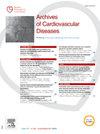Cancer therapy-related cardiac dysfunction trajectory in Breast Cancer Patients
IF 2.2
3区 医学
Q2 CARDIAC & CARDIOVASCULAR SYSTEMS
引用次数: 0
Abstract
Background
Cancer therapy-related cardiac dysfunction (CTRCD) is a significant adverse effect of cancer treatments, particularly in breast cancer patients receiving chemotherapy and/or radiation.
Objectives
This study describes the trajectory of CTRCD in this population.
Methods
A retrospective study was conducted on 77 breast cancer patients who completed chemotherapy. Demographic, clinical, and echocardiographic data were extracted from medical records. The severity of cardiotoxicity was classified as mild, moderate, or severe. Treatment patterns and recovery rates were assessed.
Results
Among the 77 patients (mean age 49.1 years), 94.9% received chemotherapy, with 57.7% receiving both anti-HER2 and anthracyclines, 29.5% anthracyclines alone, and 7.7% anti-HER2 alone. Hypertension (19.2%) was the most prevalent cardiovascular risk factor, followed by diabetes (14.1%). Risk stratification (HFA-ICOS) classified 79.5% as low risk, 11.5% as moderate, and 5.1% as high/very high risk. CTRCD occurred in 42.3% of patients, predominantly during chemotherapy (87.9%), with a mean onset of 9.6 months post-treatment. Cardiotoxicity was mild in 75.8%, moderate in 9.1%, and severe in 9.1% of cases, with symptoms in 21.2%. Baseline LVEF declined from 65.7% to 53.1%, and GLS from −21.48 to −16.31 post-toxicity. Regarding management, 60.6% of affected patients received treatment, leading to complete recovery in 51.5% and partial recovery in 9.1%, with a mean recovery time of 6.2 months.
Conclusion
CTRCD is common in breast cancer patients, mostly occurring during chemotherapy. Despite declines in LVEF and GLS, treatment led to significant recovery. These findings emphasize the importance of early detection, regular monitoring, and timely intervention to mitigate cardiotoxicity risks.
乳腺癌患者与癌症治疗相关的心功能障碍轨迹
癌症治疗相关性心功能障碍(CTRCD)是癌症治疗的一个重要不良反应,特别是在接受化疗和/或放疗的乳腺癌患者中。目的本研究描述了该人群CTRCD的发展轨迹。方法对77例完成化疗的乳腺癌患者进行回顾性研究。从医疗记录中提取人口统计学、临床和超声心动图数据。心脏毒性的严重程度分为轻度、中度和重度。评估治疗模式和康复率。结果77例患者(平均年龄49.1岁)中,94.9%接受化疗,其中57.7%同时接受抗her2和蒽环类药物治疗,29.5%单独接受蒽环类药物治疗,7.7%单独接受抗her2治疗。高血压(19.2%)是最常见的心血管危险因素,其次是糖尿病(14.1%)。风险分层(HFA-ICOS)将79.5%分类为低风险,11.5%为中度风险,5.1%为高/极高风险。42.3%的患者发生CTRCD,主要发生在化疗期间(87.9%),平均发病时间为治疗后9.6个月。心脏毒性为轻度占75.8%,中度占9.1%,重度占9.1%,有症状者占21.2%。中毒后,基线LVEF从65.7%下降到53.1%,GLS从- 21.48下降到- 16.31。在治疗方面,60.6%的患者接受了治疗,51.5%的患者完全康复,9.1%的患者部分康复,平均康复时间为6.2个月。结论ctrcd在乳腺癌患者中较为常见,多发生在化疗期间。尽管LVEF和GLS下降,但治疗导致显著恢复。这些发现强调了早期发现、定期监测和及时干预对减轻心脏毒性风险的重要性。
本文章由计算机程序翻译,如有差异,请以英文原文为准。
求助全文
约1分钟内获得全文
求助全文
来源期刊

Archives of Cardiovascular Diseases
医学-心血管系统
CiteScore
4.40
自引率
6.70%
发文量
87
审稿时长
34 days
期刊介绍:
The Journal publishes original peer-reviewed clinical and research articles, epidemiological studies, new methodological clinical approaches, review articles and editorials. Topics covered include coronary artery and valve diseases, interventional and pediatric cardiology, cardiovascular surgery, cardiomyopathy and heart failure, arrhythmias and stimulation, cardiovascular imaging, vascular medicine and hypertension, epidemiology and risk factors, and large multicenter studies. Archives of Cardiovascular Diseases also publishes abstracts of papers presented at the annual sessions of the Journées Européennes de la Société Française de Cardiologie and the guidelines edited by the French Society of Cardiology.
 求助内容:
求助内容: 应助结果提醒方式:
应助结果提醒方式:


